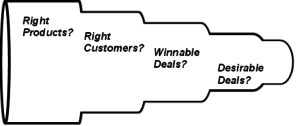The 3 Metrics that Reveal a Healthy Sales Pipeline
What’s your answer to the following question: How healthy is your sales pipeline right now?
I bet I know the question you actually answered… How big is my sales pipeline right now?
It’s a classic reaction to think first about the size of your sales pipeline – a reaction that is predicated on the belief that bigger is better. Using this metric to measure sales pipeline health is simple, but it can also be misleading. The research in our best-selling book Cracking the Sales Management Code revealed that successful sales forces take a more robust approach to measuring pipeline health. They look at three critical metrics: size, shape, and contents.
Ideal Pipeline Dimensions

1. Pipeline Size
Most people believe that a bigger pipeline is a better pipeline. However, we discovered that this to be a shaky notion. We found that sales teams with smaller pipelines can actually be more successful than their peers with a larger pipeline of deals. This sounds counter-intuitive, but it’s not.
Organizations with smaller pipelines are often more productive because sellers were very good at disqualifying bad deals early in the sales cycle, thus pursuing fewer and more desirable deals with greater attention and focus. Teams with smaller pipelines of active opportunities made 20% more prospecting calls, conducted 25% more meetings with prospects, and closed 50% more deals than their peers (measured by dollar amount). By eliminating the junk from their pipelines and using their time more wisely, these teams demonstrated that bigger is not always better.
2. Pipeline Shape
Jettisoning the junk has a profound impact on the second characteristic of a healthy sales pipeline: shape. Exorcising bad deals early in the sales process will cause the pipeline to taper dramatically in its early stages. This is highly desirable because if you drag a high percentage of bad deals late into the sales cycle, your pipelines will be fat with relatively little muscle. When it comes to sales pipelines, thin is in.
In an ideal world, the sales pipeline would look exactly like a pipe, with no taper at all! Every deal that made it into your sales pipeline would be both desirable and winnable, and you would successfully close them all: 0% waste and 100% revenue. So, take a deep breath and cull your pipeline much earlier than you currently do. The faster you get out the bad deals, the faster you will improve your bottom line.
3. Pipeline Contents
Finally, let’s look at pipeline contents, by which I mean a combination of desirable customers and products. In our research, we found that 61% of companies care deeply about the types of products they sell, and 78% really care what types of consumers they pursue. As they should… Because for a pipeline to be healthy, its contents should reflect your company’s overall go-to-market strategy with the most profitable combination of customers and products.
Elements of Successful Pipeline Management

We now know through our research and work with world-class sales forces that sale pipelines should not be judged using the traditional ‘bigger-is-better’ mindset. As sellers become more effective and go-to-market strategies become more complex, the shape and contents of your sales pipeline are just as important (perhaps even more so) than just the pipeline’s size. The combination of these three criteria are critical guideposts that predict whether your company’s sales effort will succeed or fail.
VantagePoint Performance is now part of Imparta, a global leader in performance improvement for customer-facing teams.